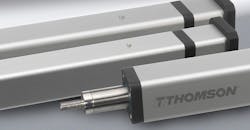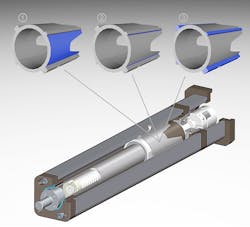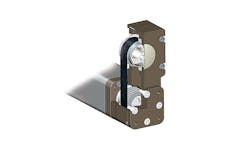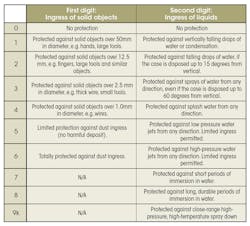The World of Actuation is Turning Electromechanical
Over recent years, demands have grown louder from factory and company managers to use more electric rod-style actuators and fewer pneumatic actuators in factory automation equipment. Several factors are driving this conversion, but the most significant include the increasing needs to:
- Improve machine performance with electromechanical actuators capable of higher precision.
- Reduce the size of equipment with electromechanical actuators that require only about a quarter of the space to deliver the same thrust as pneumatic actuators.
- Utilize energy more efficiently, because electromechanical actuators do not need air compressors running 24/7 maintaining pressure.
- Reduce maintenance and total cost of ownership, because electromechanical actuators use fewer components, do not require compressors, and do not suffer air leaks.
Once the decision is made to replace pneumatic actuators with electromechanical types, the next step is to select the right electromechanical actuators from among the many brands. Although fundamental thrust specifications may be similar, significant differences exist in the areas of lifecycle performance, maintainability, and environmental resistance.
Thomson PC Series electric actuators are designed to deliver superior performance while saving time and money thanks to easy product sizing and selection, quick and reliable installation, and reduced maintenance.
Lifecycle Performance
Generally speaking, the larger the diameter of the ball screw, the greater the thrust potential. However, achieving this requires proper mating of the thrust bearing and all fixation points, including extension tube, the inner ball nut, bearing housing, and wiper housing. Otherwise, any increase in thrust would come at the expense of system life. A component too weak to handle its load will wear out much faster or even become damaged.
You could have two actuators, each fitted with a 16-mm ball screw and providing 750 N of thrust, and one, for example, may have 2,000-km travel life, while the other provides 8,000 km of travel. The difference lies in how well the ball screw and other components are mated to each other.
Moreover, due to larger ball-screw diameters correlating with cost and footprint, properly mating the ball screw and other components reduces both. To meet an application requirement of 3,200 N of force, one vendor might use a ball screw with 20-mm diameter, while another vendor, one with properly mated components, might achieve the same thrust with a 12-mm diameter screw. Thus, the latter ball screw can be downsized without sacrificing performance.
Properly mating ball screws with other components significantly affects the life of the actuator, and, when combined with the carrier design, the two factors have the greatest impact on precision and load capacity. Another goal of actuator design is to reduce radial and lateral free play. Factors affecting this are carrier body’s diameter, the contact surface area, and the use of support legs. A larger carrier body, for example, supports larger external radial loads by maximizing surface contact area in side-load situations. The ability to side load electric actuators raises performance, precision, and compactness to a level not attainable with pneumatic or hydraulic actuators.
Side loads in actuators (1) are handled by maximizing the surface area. Increased surface area in thrust situations reduces play and supports lateral loads (2). And adding interlocked elevated legs in grooved channels along the actuator improves stability (3).
Although maximizing surface areas improves radial and lateral load capacity, it does not necessarily help stability. This is often addressed by locking elevated legs into grooved channels (three in the image above). These support legs reduce vibrations, which can add noise and contribute to wear. Most designs use one or two such ridges, thus removing some play, but it can generate clicking sounds as the system begins to wear over time. Using four legs instead of two, however, curtails wear and noise, providing more effective and durable anti-rotational protection. Plus, the additional legs ensure cling-free return motion, further reducing play due to wear.
Additionally, curving these carrier legs outwards creates radial preload, which reduces play in the thrust tube. It also centers the carrier body and ball nut, eliminating the need to shim the carrier to the extrusion and compensating for wear over the life of the device. Keeping everything in alignment cuts down on the amount of times the actuator must be calibrated for consistent idle torque.
Close tolerances are critical for lowering wear and noise reduction. But if there is no air gap at all, pressure builds when actuators run at high speeds. This causes overheating, contributing to lubrication problems and other durability issues. To address this, make two of the male key features on the carrier legs lower than the remaining two—that’s the approach Thomson takes with many of its actuators. This provides just enough gap to prevent pressure from building up. As seen in the above image, two of the male key features orthogonally situated on the carrier legs are lower than the remaining two.
Maintainability
Ease of maintenance affects lifecycle performance and contributes to productivity benefits. Electromechanical actuators differ in their lubrication and motor handling. Most actuators retract to partially expose parts by 60% to 70% for lubrication. Technicians remove the caps, locate parts that need lubrication, add grease, and may need to repeat this process.
A better approach, however, is to extend or retract the tube completely, revealing all components for maximum exposure. This lets companies use automated lubrication. In addition, using a lubrication nipple would eliminate the need to remove the cap, further simplifying maintenance.
Maintenance can also be sped up if you eliminate the time needed to mate the motor with the mechanical actuator. Traditionally mounting the motor in a parallel configuration takes 20 to 25 minutes. Once the motor is being mounted, a technician must use a variety of tools to adjust it for proper belt tension and aligning. This requires at least 12 steps.
However, if the actuator comes with a pre-assembled parallel solution, the belt can be pre-tensioned during assembly, eliminating the need for multi-step tension adjustments—the motor can be bolted down and usable in only three steps. For inline mounting, the benefits of a pre-assembled solution are similar, although not as dramatic.
Actuator design with a pre-assembled parallel solution.
Additionally, using straddle-mount bearings eliminates the risk of misalignment. It also protects the motor shaft from radial loads, which reduces noise and further extends actuator life.
Environmental Resistance
Electromechanical actuators differ in their ability to withstand harsh conditions, the environment, and frequent high-pressure washdowns. This depends on the exterior profile, material choice, and sealing methods.
Profiles with smooth surfaces are cleaner than grooved surfaces because they do not accumulate dust and fluids. Thus, they are more appropriate for harsh environments when frequent washdowns are required. There could be a downside to having a sleek exterior, though. If used in applications that require sensor attachments, an extra plastic add-on might be necessary to attach the sensor.
Environmental resistance also depends on the material composition of the extension tube. Most systems use chrome steel, but stainless steel is a much better choice for harsh environments.
A key indicator of resistance to the environment is the Ingress Protection (IP) Code from the National Electrical Manufacturers Association (NEMA) (see table). An IP rating of 65, for example, means that the device is dustproof and protected against low-pressure water jets from any direction, as might be found in a food and beverage industry washdown operation. Only a few electric actuators meet this rating, but in corrosive environments, it is critical. An IP rating of 54 provides some protection against splashed water and less than 100% protection against dust, making it acceptable for some washdown applications, but not if pressure is involved. An IP rating of 40, which is common among linear actuators, implies that there is no dust or liquid protection.
Higher IP ratings mainly depend on using better seals. Thomson, for example, seals every compartment, including motor mounts, on its electromechanical actuators. All gaskets should also be sealed and extend all the way back to the motor rather than stopping at the mounting plate.
The Next Generation of Motion Control
As market demands grow for higher productivity, shorter changeover times, increased reliability, greater energy savings, and lower maintenance and operating costs, more and more designers and end users are switching to electromechanical over pneumatic actuators. For machinery requiring sophisticated motion control, electromechanical actuators are practically the only alternative. But even for simple linear motion tasks, motion-control designers and users lean toward electric actuation due to less and/or easier maintenance, increased energy savings, and cleaner operation.
Even greater benefits are possible by carefully comparing different brands of electric actuators. Always interpret “load-carrying capability” in the context of claimed system life and space requirements. There are real tradeoffs in these areas. Carrier design affects precision as well as lateral and rotary load-bearing capabilities, so pay close attention to how the carrier is secured in the channel, and to the shape and size of any guidance mechanisms.
Improved mechanisms and parts such as support legs and leg designs, which can be curved for better gripping, will improve accuracy and wear. And the appropriate exterior profile, material choices, and sealing strategy are key factors for environmental resistance. Smoother profiles, stainless-steel materials, and higher IP ratings tend to offer the greatest protection.
Visit www.thomsonlinear.com/pcseries for further information and to learn more about the benefits of converting from pneumatic to electric actuation, including a free energy savings calculator.
Niklas Sjöström is Product Line Manager, Systems Group, at Thomson Industries Inc.





